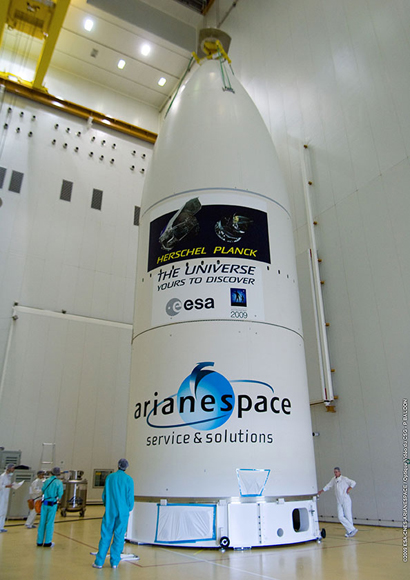Two major European Space Agency astronomical missions set for launch
13 May 2009

The European Space Agency (ESA) will launch two major astronomical spacecraft, Herschel and Planck, at 15:12 CEST (13:12 UTC) on 14 May 2009 from Europe's Spaceport in Kourou, French Guiana. Proudly displayed on the fairing of the Ariane 5 ECA launcher will be the logo and motto of the International Year of Astronomy 2009.
The International Year of Astronomy is bound for space
The launch of the IYA2009 logo and motto with Herschel and Planck is just one of the many activities in which ESA is participating in recognition of the International Year of Astronomy. ESA is contributing to IYA2009 in two ways: by direct involvement in a selected number of IYA2009 cornerstone activities, and with special activities designed to promote ESA's special place in modern astronomy. Activities include a workshop for the Galileo Teacher Training Programme that will take place in June and an exclusive competition for secondary students and University undergraduate to ‘Be an INTEGRAL Astronomer'. There is also the Groningen Discovery Truck - featuring Herschel, and ‘Looking back to the dawn of time' - an exhibition devoted to Planck.The European Space Agency (ESA) will launch two major astronomical spacecraft, Herschel and Planck, at 15:12 CEST (13:12 UTC) on 14 May 2009 from Europe's Spaceport in Kourou, French Guiana. Proudly displayed on the fairing of the Ariane 5 ECA launcher will be the logo and motto of the International Year of Astronomy 2009.
The International Year of Astronomy is bound for space
The launch of Herschel and Planck marks a sizeable European contribution to the International Year of Astronomy 2009 (IYA2009). In recognition of this, an IYA2009 banner that is 1.6 metres tall and 3.4 meters wide has been affixed to the central section of the fairing, just below the Herschel and Planck banner. The IYA2009 banner carries the logo of the International Year of Astronomy and the motto: "The Universe - Yours to Discover".
The launcher fairing protects the spacecraft during the early of stages of launch. Four minutes after launch, at a height of about 145 kilometres above the Earth, the fairing, carrying the International Year of Astronomy logo, is jettisoned. At about 25 minutes after launch the Herschel spacecraft will separate from the launcher. This is soon followed by the separation of the Planck spacecraft. Both will then be en route to their final orbits approximately 1.5 million kilometres from Earth at the second Lagrange point, L2.
This is the second occasion that the International Year of Astronomy logo has blasted into space. The first occasion was when Japanese astronaut Koichi Wakata carried an official flight kit bearing the IYA2009 logo during his 15 March 2009 flight on the Space Shuttle Discovery to the International Space Station. The kit was later returned to Earth and will be on display in Japan in the autumn.
Follow the launch
The Herschel infrared space observatory and the Planck survey mission will be launched together by a single Ariane 5 ECA launcher. These are two of the most sophisticated astronomical spacecraft ever built. Both missions will significantly contribute to a better understanding of our Universe. You can find out what it takes to launch space missions like Herschel and Planck, more about the individual missions and follow the launch by visiting their dedicated websites using the links in the right-hand menu. The launch will be broadcast live on the ESA channel on mogulus and on the Arianespace web site.
ESA's contribution to the International Year of Astronomy 2009
The launch of the IYA2009 logo and motto with Herschel and Planck is just one of the many activities in which ESA is participating in recognition of the International Year of Astronomy. ESA is contributing to IYA2009 in two ways: by direct involvement in a selected number of IYA2009 cornerstone activities, and with special activities designed to promote ESA's special place in modern astronomy. Activities include a workshop for the Galileo Teacher Training Programme that will take place in June and an exclusive competition for secondary students and University undergraduate to ‘Be an INTEGRAL Astronomer'. There is also the Groningen Discovery Truck - featuring Herschel, and ‘Looking back to the dawn of time' - an exhibition devoted to Planck.
To find out more about all ESA International Year of Astronomy activities visit the dedicated website astronomy2009.esa.int
Herschel - ESA's cutting edge infrared space observatory
Herschel is the largest ever infrared space observatory, the first of a new generation of space giants. Herschel will probe deeper into the infrared than ever before, opening up a completely unexplored infrared window onto the Universe; the far infrared and sub-millimetre portion of the electromagnetic spectrum. Herschel will observe some of the coolest and most distant objects in the Universe in order to build a better understanding of stellar and galaxy formation and evolution.
Planck - ESA's survey mission looking back to the dawn of time
Planck is Europe's first mission to scan the entire sky and produce maps of the Cosmic Microwave Background, the remnant radiation that filled the Universe immediately after the Big Bang. The aim of Planck is to provide answers to some of the biggest questions in science today such as: How did the Universe begin? How did it evolve to the state that we can observe today and how will it continue to evolve in the future?
See also
- Herschel and Planck launch website: http://www.esa.int/SPECIALS/herschelplanck/index.html
- Herschel (Overview) http://www.esa.int/SPECIALS/Herschel/index.html
- Herschel (In depth) http://planck.esa.int/science-e/www/area/index.cfm?fareaid=16
- Planck (Overview) http://www.esa.int/SPECIALS/Planck/index.html
- Planck (In depth) http://planck.esa.int/science-e/www/area/index.cfm?fareaid=17
- Follow the launch live with ESA: http://www.mogulus.com/eurospaceagency
- Follow the launch live with Arianespace: http://www.videocorner.tv/videocorner2/live_flv/index.php?langue=en
- Science@ESA Vodcast - Exploring the Infrared Universe: http://astronomy2009.esa.int/science-e/www/object/index.cfm?fobjectid=44774
- Science@ESA Vodcast - Looking back to the Dawn of Time http://astronomy2009.esa.int/science-e/www/object/index.cfm?fobjectid=44366
Search IYA2009 Updates

National Nodes: 148
Organisational Nodes: 40
Organisational Associates:33
National Websites: 111
Cornerstone Projects: 12
Special Task Groups: 11
Special Projects:16
Official Products:8
Media Partners:22


